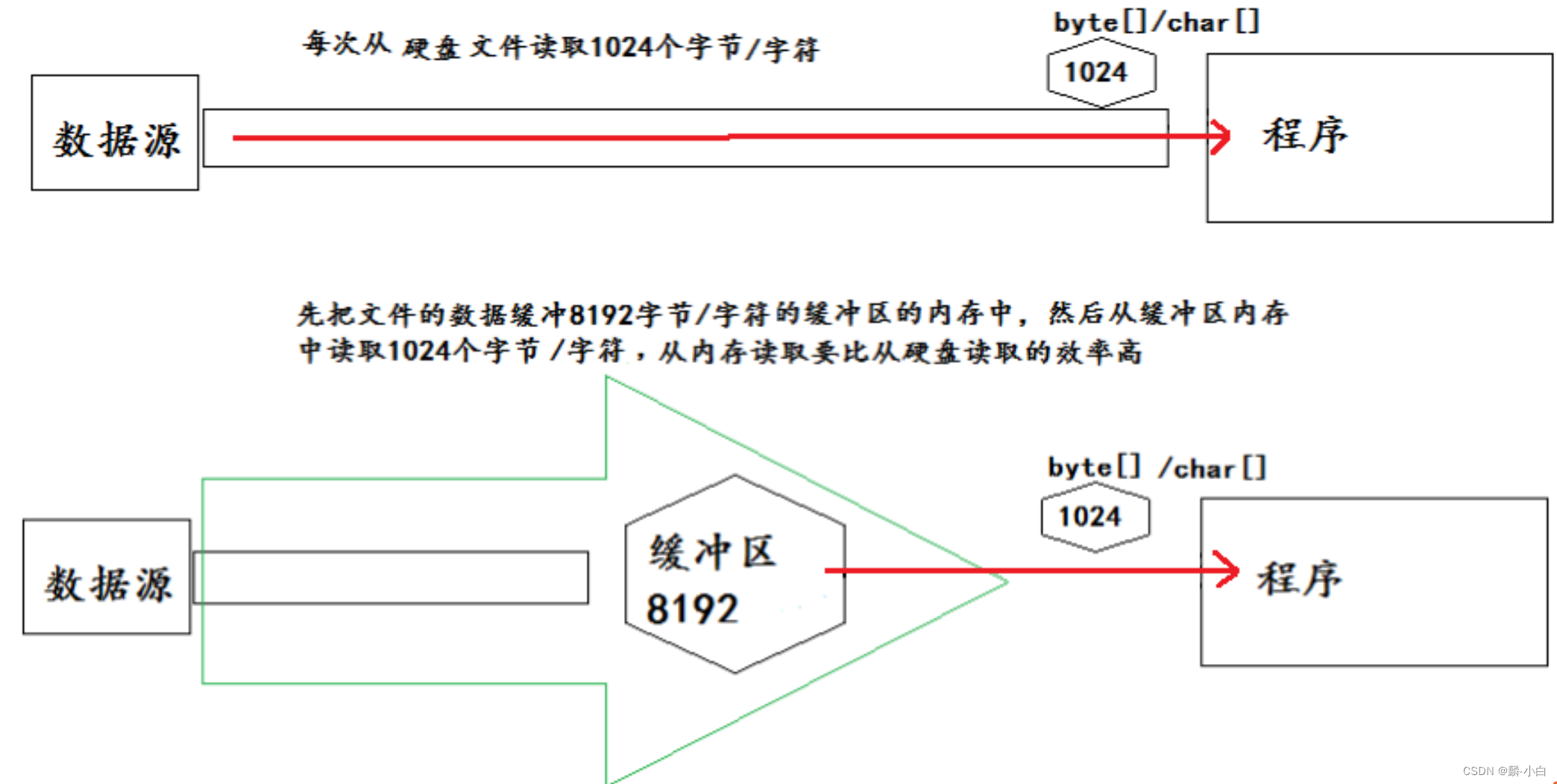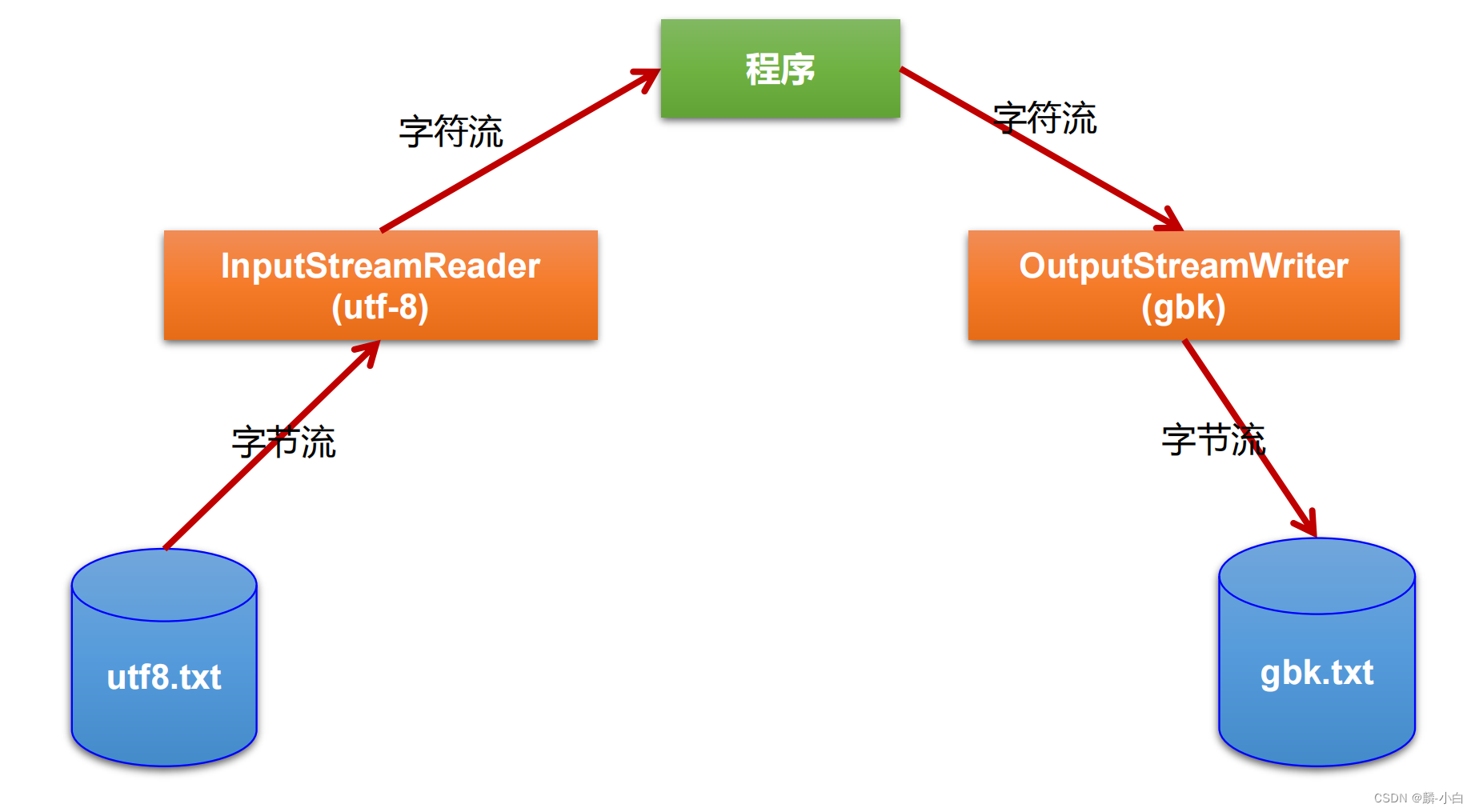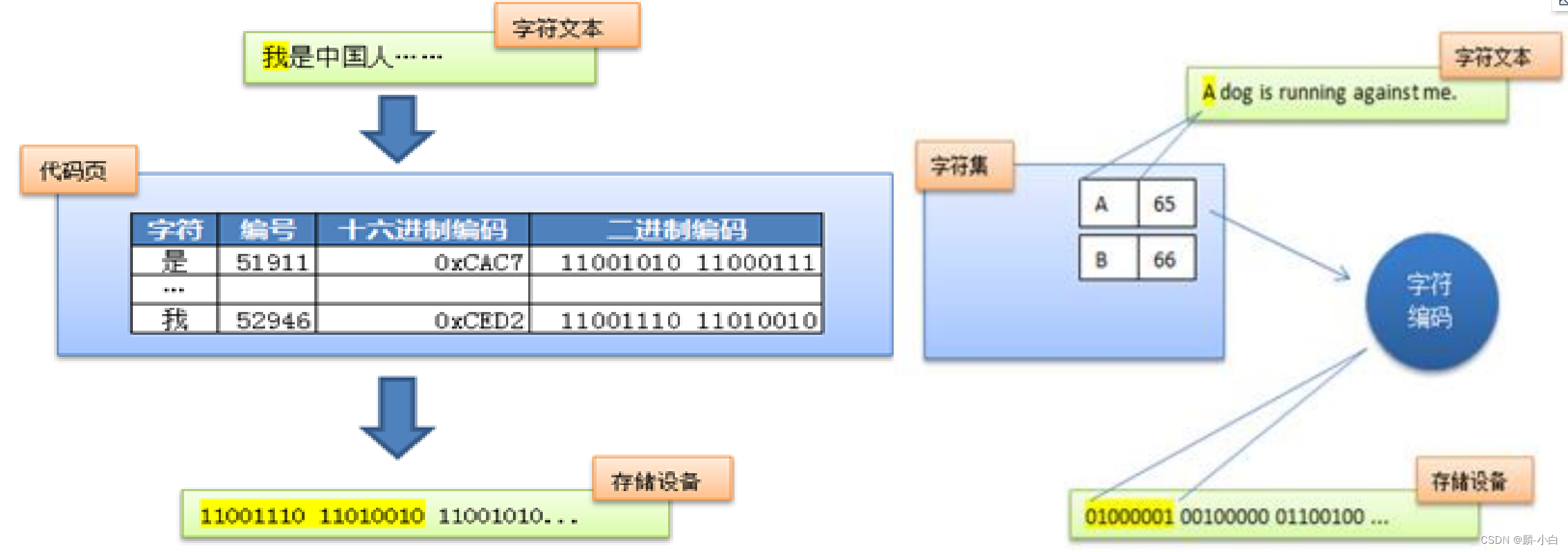写在前面
Hello大家好, 我是【麟-小白】,一位软件工程专业的学生,喜好计算机知识。希望大家能够一起学习进步呀!本人是一名在读大学生,专业水平有限,如发现错误或不足之处,请多多指正!谢谢大家!!!
如果小哥哥小姐姐们对我的文章感兴趣,请不要吝啬你们的小手,多多点赞加关注呀!❤❤❤ 爱你们!!!
目录
【往期回顾】
1. 节点流(或文件流)
1.1 读取文件
1. 建立一个流对象,将已存在的一个文件加载进流。
- FileReader fr = new FileReader(new File(“Test.txt”));
2. 创建一个临时存放数据的数组。
- char[] ch = new char[1024];
3. 调用流对象的读取方法将流中的数据读入到数组中。
- fr.read(ch);
4. 关闭资源。
- fr.close();
FileReader fr = null; try { fr = new FileReader(new File("c:\\test.txt")); char[] buf = new char[1024]; int len; while ((len = fr.read(buf)) != -1) { System.out.print(new String(buf, 0, len)); } } catch (IOException e) { System.out.println("read-Exception :" + e.getMessage()); } finally { if (fr != null) { try { fr.close(); } catch (IOException e) { System.out.println("close-Exception :" + e.getMessage()); } } }
1.2 写入文件
1. 创建流对象,建立数据存放文件
- FileWriter fw = new FileWriter(new File(“Test.txt”));
2. 调用流对象的写入方法,将数据写入流
- fw.write(“atguigu-songhongkang”);
3. 关闭流资源,并将流中的数据清空到文件中。
- fw.close();
FileWriter fw = null; try { fw = new FileWriter(new File("Test.txt")); fw.write("atguigu-songhongkang"); } catch (IOException e) { e.printStackTrace(); } finally { if (fw != null) { try { fw.close(); } catch (IOException e) { e.printStackTrace(); } } }
1.3 注意点
- 定义文件路径时,注意:可以用“/”或者“\\”。
- 在写入一个文件时,如果使用构造器FileOutputStream(file),则目录下有同名文件将被覆盖。
- 如果使用构造器FileOutputStream(file,true),则目录下的同名文件不会被覆盖,在文件内容末尾追加内容。
- 在读取文件时,必须保证该文件已存在,否则报异常。
- 字节流操作字节,比如:.mp3,.avi,.rmvb,mp4,.jpg,.doc,.ppt
- 字符流操作字符,只能操作普通文本文件。最常见的文本文件:.txt,.java,.c,.cpp 等语言的源代码。尤其注意.doc,excel,ppt这些不是文本文件。
1.4 节点流代码演示
import org.junit.Test; import java.io.*; /** * 测试FileInputStream和FileOutputStream的使用 * * 结论: * 1. 对于文本文件(.txt,.java,.c,.cpp),使用字符流处理 * 2. 对于非文本文件(.jpg,.mp3,.mp4,.avi,.doc,.ppt,...),使用字节流处理 * @author 麟-小白 */ public class FileInputOutputStreamTest { /** 使用字节流FileInputStream处理文本文件,可能出现乱码。 */ @Test public void testFileInputStream() { FileInputStream fis = null; try { //1. 造文件 File file = new File("hello.txt"); //2.造流 fis = new FileInputStream(file); //3.读数据 byte[] buffer = new byte[5]; int len;//记录每次读取的字节的个数 while ((len = fis.read(buffer)) != -1) { String str = new String(buffer, 0, len); System.out.print(str); } } catch (IOException e) { e.printStackTrace(); } finally { if (fis != null) { //4.关闭资源 try { fis.close(); } catch (IOException e) { e.printStackTrace(); } } } } /** 实现对图片的复制操作 */ @Test public void testFileInputOutputStream() { FileInputStream fis = null; FileOutputStream fos = null; try { // File srcFile = new File("爱情与友情.jpg"); File destFile = new File("爱情与友情2.jpg"); // fis = new FileInputStream(srcFile); fos = new FileOutputStream(destFile); //复制的过程 byte[] buffer = new byte[5]; int len; while ((len = fis.read(buffer)) != -1) { fos.write(buffer, 0, len); } } catch (IOException e) { e.printStackTrace(); } finally { if (fos != null) { try { fos.close(); } catch (IOException e) { e.printStackTrace(); } } if (fis != null) { try { fis.close(); } catch (IOException e) { e.printStackTrace(); } } } } /** 指定路径下文件的复制 */ public void copyFile(String srcPath, String destPath) { FileInputStream fis = null; FileOutputStream fos = null; try { // File srcFile = new File(srcPath); File destFile = new File(destPath); // fis = new FileInputStream(srcFile); fos = new FileOutputStream(destFile); //复制的过程 byte[] buffer = new byte[1024]; int len; while ((len = fis.read(buffer)) != -1) { fos.write(buffer, 0, len); } } catch (IOException e) { e.printStackTrace(); } finally { if (fos != null) { try { fos.close(); } catch (IOException e) { e.printStackTrace(); } } if (fis != null) { try { fis.close(); } catch (IOException e) { e.printStackTrace(); } } } } @Test public void testCopyFile() { long start = System.currentTimeMillis(); String srcPath = "C:\\Users\\Administrator\\Desktop\\01-视频.avi"; String destPath = "C:\\Users\\Administrator\\Desktop\\02-视频.avi"; /* * String srcPath = "hello.txt"; * String destPath = "hello3.txt"; */ copyFile(srcPath, destPath); long end = System.currentTimeMillis(); //618 System.out.println("复制操作花费的时间为:" + (end - start)); } }
![]()
2. 缓冲流
2.1 缓冲流概述
- 为了提高数据读写的速度,Java API提供了带缓冲功能的流类,在使用这些流类时,会创建一个内部缓冲区数组,缺省使用8192个字节(8Kb)的缓冲区。
- 缓冲流要“套接”在相应的节点流之上,根据数据操作单位可以把缓冲流分为:
- BufferedInputStream 和 BufferedOutputStream
- BufferedReader 和 BufferedWriter
- 当读取数据时,数据按块读入缓冲区,其后的读操作则直接访问缓冲区
- 当使用BufferedInputStream读取字节文件时,BufferedInputStream会一次性从文件中读取8192个(8Kb),存在缓冲区中,直到缓冲区装满了,才重新从文件中读取下一个8192个字节数组。
- 向流中写入字节时,不会直接写到文件,先写到缓冲区中直到缓冲区写满,BufferedOutputStream才会把缓冲区中的数据一次性写到文件里。使用方法flush()可以强制将缓冲区的内容全部写入输出流
- 关闭流的顺序和打开流的顺序相反。只要关闭最外层流即可,关闭最外层流也会相应关闭内层节点流
- flush()方法的使用:手动将buffer中内容写入文件
- 如果是带缓冲区的流对象的close()方法,不但会关闭流,还会在关闭流之前刷新缓冲区,关闭后不能再写出
2.2 缓冲流代码演示
BufferedReader br = null; BufferedWriter bw = null; try { // 创建缓冲流对象:它是处理流,是对节点流的包装 br = new BufferedReader(new FileReader("d:\\IOTest\\source.txt")); bw = new BufferedWriter(new FileWriter("d:\\IOTest\\dest.txt")); String str; // 一次读取字符文本文件的一行字符 while ((str = br.readLine()) != null) { // 一次写入一行字符串 bw.write(str); // 写入行分隔符 bw.newLine(); } // 刷新缓冲区 bw.flush(); // 刷新缓冲区 } catch (IOException e) { e.printStackTrace(); } finally { // 关闭IO流对象 try { if (bw != null) { // 关闭过滤流时,会自动关闭它所包装的底层节点流 bw.close(); } } catch (IOException e) { e.printStackTrace(); } try { if (br != null) { br.close(); } } catch (IOException e) { e.printStackTrace(); } }import org.junit.Test; import java.io.*; /** * 处理流之一:缓冲流的使用 * * 1.缓冲流: * BufferedInputStream * BufferedOutputStream * BufferedReader * BufferedWriter * * 2.作用:提高流的读取、写入的速度 * 提高读写速度的原因:内部提供了一个缓冲区 * * 3. 处理流,就是“套接”在已有的流的基础上。 * @author 麟-小白 */ public class BufferedTest { /** 实现非文本文件的复制 */ @Test public void bufferedStreamTest() throws FileNotFoundException { BufferedInputStream bis = null; BufferedOutputStream bos = null; try { //1.造文件 File srcFile = new File("爱情与友情.jpg"); File destFile = new File("爱情与友情3.jpg"); //2.造流 //2.1 造节点流 FileInputStream fis = new FileInputStream((srcFile)); FileOutputStream fos = new FileOutputStream(destFile); //2.2 造缓冲流 bis = new BufferedInputStream(fis); bos = new BufferedOutputStream(fos); //3.复制的细节:读取、写入 byte[] buffer = new byte[10]; int len; while ((len = bis.read(buffer)) != -1) { bos.write(buffer, 0, len); // bos.flush();//刷新缓冲区 } } catch (IOException e) { e.printStackTrace(); } finally { //4.资源关闭 //要求:先关闭外层的流,再关闭内层的流 if (bos != null) { try { bos.close(); } catch (IOException e) { e.printStackTrace(); } } if (bis != null) { try { bis.close(); } catch (IOException e) { e.printStackTrace(); } } //说明:关闭外层流的同时,内层流也会自动的进行关闭。关于内层流的关闭,我们可以省略. // fos.close(); // fis.close(); } } /** * 实现文件复制的方法 */ public void copyFileWithBuffered(String srcPath, String destPath) { BufferedInputStream bis = null; BufferedOutputStream bos = null; try { //1.造文件 File srcFile = new File(srcPath); File destFile = new File(destPath); //2.造流 //2.1 造节点流 FileInputStream fis = new FileInputStream((srcFile)); FileOutputStream fos = new FileOutputStream(destFile); //2.2 造缓冲流 bis = new BufferedInputStream(fis); bos = new BufferedOutputStream(fos); //3.复制的细节:读取、写入 byte[] buffer = new byte[1024]; int len; while ((len = bis.read(buffer)) != -1) { bos.write(buffer, 0, len); } } catch (IOException e) { e.printStackTrace(); } finally { //4.资源关闭 //要求:先关闭外层的流,再关闭内层的流 if (bos != null) { try { bos.close(); } catch (IOException e) { e.printStackTrace(); } } if (bis != null) { try { bis.close(); } catch (IOException e) { e.printStackTrace(); } } //说明:关闭外层流的同时,内层流也会自动的进行关闭。关于内层流的关闭,我们可以省略. // fos.close(); // fis.close(); } } @Test public void testCopyFileWithBuffered() { long start = System.currentTimeMillis(); String srcPath = "C:\\Users\\Administrator\\Desktop\\01-视频.avi"; String destPath = "C:\\Users\\Administrator\\Desktop\\03-视频.avi"; copyFileWithBuffered(srcPath, destPath); long end = System.currentTimeMillis(); //618 - 176 System.out.println("复制操作花费的时间为:" + (end - start)); } /** 使用BufferedReader和BufferedWriter实现文本文件的复制 */ @Test public void testBufferedReaderBufferedWriter() { BufferedReader br = null; BufferedWriter bw = null; try { //创建文件和相应的流 br = new BufferedReader(new FileReader(new File("dbcp.txt"))); bw = new BufferedWriter(new FileWriter(new File("dbcp1.txt"))); //读写操作 //方式一:使用char[]数组 // char[] cbuf = new char[1024]; // int len; // while((len = br.read(cbuf)) != -1){ // bw.write(cbuf,0,len); // bw.flush(); // } //方式二:使用String String data; while ((data = br.readLine()) != null) { //方法一: // bw.write(data + "\n");//data中不包含换行符 //方法二: //data中不包含换行符 bw.write(data); //提供换行的操作 bw.newLine(); } } catch (IOException e) { e.printStackTrace(); } finally { //关闭资源 if (bw != null) { try { bw.close(); } catch (IOException e) { e.printStackTrace(); } } if (br != null) { try { br.close(); } catch (IOException e) { e.printStackTrace(); } } } } }
2.3 练习
练习一:图片的加密
import org.junit.Test; import java.io.FileInputStream; import java.io.FileOutputStream; import java.io.IOException; /** * @author 麟-小白 */ public class PicTest { //图片的加密 @Test public void test1() { FileInputStream fis = null; FileOutputStream fos = null; try { fis = new FileInputStream("爱情与友情.jpg"); fos = new FileOutputStream("爱情与友情secret.jpg"); byte[] buffer = new byte[20]; int len; while ((len = fis.read(buffer)) != -1) { //字节数组进行修改 //错误的 // for(byte b : buffer) { // b = (byte) (b ^ 5); // } //正确的 for (int i = 0; i < len; i++) { buffer[i] = (byte) (buffer[i] ^ 5); } fos.write(buffer, 0, len); } } catch (IOException e) { e.printStackTrace(); } finally { if (fos != null) { try { fos.close(); } catch (IOException e) { e.printStackTrace(); } } if (fis != null) { try { fis.close(); } catch (IOException e) { e.printStackTrace(); } } } } //图片的解密 @Test public void test2() { FileInputStream fis = null; FileOutputStream fos = null; try { fis = new FileInputStream("爱情与友情secret.jpg"); fos = new FileOutputStream("爱情与友情4.jpg"); byte[] buffer = new byte[20]; int len; while ((len = fis.read(buffer)) != -1) { //字节数组进行修改 // 错误的 // for(byte b : buffer) { // b = (byte) (b ^ 5); // } //正确的 for (int i = 0; i < len; i++) { buffer[i] = (byte) (buffer[i] ^ 5); } fos.write(buffer, 0, len); } } catch (IOException e) { e.printStackTrace(); } finally { if (fos != null) { try { fos.close(); } catch (IOException e) { e.printStackTrace(); } } if (fis != null) { try { fis.close(); } catch (IOException e) { e.printStackTrace(); } } } } }练习二:获取文本上每个字符出现的次数
提示:遍历文本的每一个字符;字符及出现的次数保存在 Map 中;将 Map 中数据写入文件import org.junit.Test; import java.io.*; import java.util.HashMap; import java.util.Map; import java.util.Set; /** * 练习3:获取文本上字符出现的次数,把数据写入文件 * * 思路: * 1.遍历文本每一个字符 * 2.字符出现的次数存在Map中 * * Map<Character,Integer> map = new HashMap<Character,Integer>(); * map.put('a',18); * map.put('你',2); * * 3.把map中的数据写入文件 * * @author 麟-小白 */ public class WordCount { /** 说明:如果使用单元测试,文件相对路径为当前module 如果使用main()测试,文件相对路径为当前工程 */ @Test public void testWordCount() { FileReader fr = null; BufferedWriter bw = null; try { //1.创建Map集合 Map<Character, Integer> map = new HashMap<Character, Integer>(); //2.遍历每一个字符,每一个字符出现的次数放到map中 fr = new FileReader("dbcp.txt"); int c = 0; while ((c = fr.read()) != -1) { //int 还原 char char ch = (char) c; // 判断char是否在map中第一次出现 if (map.get(ch) == null) { map.put(ch, 1); } else { map.put(ch, map.get(ch) + 1); } } //3.把map中数据存在文件count.txt //3.1 创建Writer bw = new BufferedWriter(new FileWriter("wordcount.txt")); //3.2 遍历map,再写入数据 Set<Map.Entry<Character, Integer>> entrySet = map.entrySet(); for (Map.Entry<Character, Integer> entry : entrySet) { switch (entry.getKey()) { case ' ': bw.write("空格=" + entry.getValue()); break; //\t表示tab 键字符 case '\t': bw.write("tab键=" + entry.getValue()); break; case '\r': bw.write("回车=" + entry.getValue()); break; case '\n': bw.write("换行=" + entry.getValue()); break; default: bw.write(entry.getKey() + "=" + entry.getValue()); break; } bw.newLine(); } } catch (IOException e) { e.printStackTrace(); } finally { //4.关流 if (fr != null) { try { fr.close(); } catch (IOException e) { e.printStackTrace(); } } if (bw != null) { try { bw.close(); } catch (IOException e) { e.printStackTrace(); } } } } }
![]()
3. 转换流
3.1 转换流概述
- 转换流提供了在字节流和字符流之间的转换
- Java API提供了两个转换流:
- InputStreamReader:将InputStream转换为Reader
- OutputStreamWriter:将Writer转换为OutputStream
- 字节流中的数据都是字符时,转成字符流操作更高效。
- 很多时候我们使用转换流来处理文件乱码问题。实现编码和解码的功能。
InputStreamReader
- 实现将字节的输入流按指定字符集转换为字符的输入流。
- 需要和InputStream“套接”。
构造器
- public InputStreamReader(InputStream in)
- public InputSreamReader(InputStream in,String charsetName)
- 如: Reader isr = new InputStreamReader(System.in,”gbk”);
OutputStreamWriter
- 实现将字符的输出流按指定字符集转换为字节的输出流。
- 需要和OutputStream“套接”。
构造器
- public OutputStreamWriter(OutputStream out)
- public OutputSreamWriter(OutputStream out,String charsetName)
public void testMyInput() throws Exception { FileInputStream fis = new FileInputStream("dbcp.txt"); FileOutputStream fos = new FileOutputStream("dbcp5.txt"); InputStreamReader isr = new InputStreamReader(fis, "GBK"); OutputStreamWriter osw = new OutputStreamWriter(fos, "GBK"); BufferedReader br = new BufferedReader(isr); BufferedWriter bw = new BufferedWriter(osw); String str = null; while ((str = br.readLine()) != null) { bw.write(str); bw.newLine(); bw.flush(); } bw.close(); br.close(); }
3.2 补充:字符编码
编码表的由来
- 计算机只能识别二进制数据,早期由来是电信号。为了方便应用计算机,让它可以识别各个国家的文字。就将各个国家的文字用数字来表示,并一一对应,形成一张表。这就是编码表。
常见的编码表
- ASCII:美国标准信息交换码。
- 用一个字节的7位可以表示。
- ISO8859-1:拉丁码表。欧洲码表
- 用一个字节的8位表示。
- GB2312:中国的中文编码表。最多两个字节编码所有字符
- GBK:中国的中文编码表升级,融合了更多的中文文字符号。最多两个字节编码
- Unicode:国际标准码,融合了目前人类使用的所有字符。为每个字符分配唯一的字符码。所有的文字都用两个字节来表示。
- UTF-8:变长的编码方式,可用1-4个字节来表示一个字符。
- Unicode不完美,这里就有三个问题,一个是,我们已经知道,英文字母只用一个字节表示就够了,第二个问题是如何才能区别Unicode和ASCII?计算机怎么知道两个字节表示一个符号,而不是分别表示两个符号呢?第三个,如果和GBK等双字节编码方式一样,用最高位是1或0表示两个字节和一个字节,就少了很多值无法用于表示字符,不够表示所有字符。Unicode在很长一段时间内无法推广,直到互联网的出现。
- 面向传输的众多 UTF(UCS Transfer Format)标准出现了,顾名思义,UTF-8就是每次8个位传输数据,而UTF-16就是每次16个位。这是为传输而设计的编码,并使编码无国界,这样就可以显示全世界上所有文化的字符了。
- Unicode只是定义了一个庞大的、全球通用的字符集,并为每个字符规定了唯一确定的编号,具体存储成什么样的字节流,取决于字符编码方案。推荐的Unicode编码是UTF-8和UTF-16。
- 在Unicode出现之前,所有的字符集都是和具体编码方案绑定在一起的(即字符集≈编码方式),都是直接将字符和最终字节流绑定死了。
- GBK等双字节编码方式,用最高位是1或0表示两个字节和一个字节。
- ANSI编码,通常指的是平台的默认编码,例如英文操作系统中是ISO-8859-1,中文系统是GBK
- Unicode字符集只是定义了字符的集合和唯一编号,Unicode编码,则是对UTF-8、UCS-2/UTF-16等具体编码方案的统称而已,并不是具体的编码方案。
 转换流的编码应用
转换流的编码应用
- 可以将字符按指定编码格式存储
- 可以对文本数据按指定编码格式来解读
- 指定编码表的动作由构造器完成
3.3 转换流代码演示
import org.junit.Test; import java.io.*; /** * 处理流之二:转换流的使用 * 1.转换流:属于字符流 * InputStreamReader:将一个字节的输入流转换为字符的输入流 * OutputStreamWriter:将一个字符的输出流转换为字节的输出流 * * 2.作用:提供字节流与字符流之间的转换 * * 3. 解码:字节、字节数组 --->字符数组、字符串 * 编码:字符数组、字符串 ---> 字节、字节数组 * * 4.字符集 *ASCII:美国标准信息交换码。 用一个字节的7位可以表示。 ISO8859-1:拉丁码表。欧洲码表 用一个字节的8位表示。 GB2312:中国的中文编码表。最多两个字节编码所有字符 GBK:中国的中文编码表升级,融合了更多的中文文字符号。最多两个字节编码 Unicode:国际标准码,融合了目前人类使用的所有字符。为每个字符分配唯一的字符码。所有的文字都用两个字节来表示。 UTF-8:变长的编码方式,可用1-4个字节来表示一个字符。 * @author 麟-小白 */ public class InputStreamReaderTest { /** 此时处理异常的话,仍然应该使用try-catch-finally InputStreamReader的使用,实现字节的输入流到字符的输入流的转换 */ @Test public void test1() throws IOException { FileInputStream fis = new FileInputStream("dbcp.txt"); //InputStreamReader isr = new InputStreamReader(fis);//使用系统默认的字符集 //参数2指明了字符集,具体使用哪个字符集,取决于文件dbcp.txt保存时使用的字符集 //使用系统默认的字符集 InputStreamReader isr = new InputStreamReader(fis,"UTF-8"); char[] cbuf = new char[20]; int len; while((len = isr.read(cbuf)) != -1){ String str = new String(cbuf,0,len); System.out.print(str); } isr.close(); } /** 此时处理异常的话,仍然应该使用try-catch-finally 综合使用InputStreamReader和OutputStreamWriter */ @Test public void test2() throws Exception { //1.造文件、造流 File file1 = new File("dbcp.txt"); File file2 = new File("dbcp_gbk.txt"); FileInputStream fis = new FileInputStream(file1); FileOutputStream fos = new FileOutputStream(file2); InputStreamReader isr = new InputStreamReader(fis,"utf-8"); OutputStreamWriter osw = new OutputStreamWriter(fos,"gbk"); //2.读写过程 char[] cbuf = new char[20]; int len; while((len = isr.read(cbuf)) != -1){ osw.write(cbuf,0,len); } //3.关闭资源 isr.close(); osw.close(); } }
![]()
4. 其他流
4.1 标准输入、输出流
- System.in和System.out分别代表了系统标准的输入和输出设备
- 默认输入设备是:键盘,输出设备是:显示器
- System.in的类型是InputStream
- System.out的类型是PrintStream,其是OutputStream的子类FilterOutputStream 的子类
- 重定向:通过System类的setIn,setOut方法对默认设备进行改变。
- public static void setIn(InputStream in)
- public static void setOut(PrintStream out)
例题:从键盘输入字符串,要求将读取到的整行字符串转成大写输出。然后继续进行输入操作,直至当输入“e”或者“exit”时,退出程序。
public static void main(String[] args) { BufferedReader br = null; try { InputStreamReader isr = new InputStreamReader(System.in); br = new BufferedReader(isr); while (true) { System.out.println("请输入字符串:"); String data = br.readLine(); if ("e".equalsIgnoreCase(data) || "exit".equalsIgnoreCase(data)) { System.out.println("程序结束"); break; } String upperCase = data.toUpperCase(); System.out.println(upperCase); } } catch (IOException e) { e.printStackTrace(); } finally { if (br != null) { try { br.close(); } catch (IOException e) { e.printStackTrace(); } } } } }
4.2 打印流
- 实现将基本数据类型的数据格式转化为字符串输出
- 打印流:PrintStream和PrintWriter
- 提供了一系列重载的print()和println()方法,用于多种数据类型的输出
- PrintStream和PrintWriter的输出不会抛出IOException异常
- PrintStream和PrintWriter有自动flush功能
- PrintStream 打印的所有字符都使用平台的默认字符编码转换为字节。在需要写入字符而不是写入字节的情况下,应该使用 PrintWriter 类。
- System.out返回的是PrintStream的实例
public void test2() { PrintStream ps = null; try { FileOutputStream fos = new FileOutputStream(new File("D:\\IO\\text.txt")); // 创建打印输出流,设置为自动刷新模式(写入换行符或字节 '\n' 时都会刷新输出缓冲区) ps = new PrintStream(fos, true); // 把标准输出流(控制台输出)改成文件 if (ps != null) { System.setOut(ps); } // 输出ASCII字符 final int maxCharValue = 255; for (int i = 0; i <= maxCharValue; i++) { System.out.print((char) i); // 每50个数据一行 if (i % 50 == 0) { // 换行 System.out.println(); } } } catch (FileNotFoundException e) { e.printStackTrace(); } finally { if (ps != null) { ps.close(); } } } }
4.3 数据流
- 为了方便地操作Java语言的基本数据类型和String的数据,可以使用数据流。
- 数据流有两个类:(用于读取和写出基本数据类型、String类的数据)
- DataInputStream 和 DataOutputStream
- 分别“套接”在 InputStream 和 OutputStream 子类的流上
DataInputStream 中的方法
- boolean readBoolean()
- byte readByte()
- char readChar()
- float readFloat()
- double readDouble()
- short readShort()
- long readLong()
- int readInt()
- String readUTF() void readFully(byte[] b)
DataOutputStream 中的方法
- 将上述的方法的read改为相应的write即可。
DataOutputStream dos = null; // 创建连接到指定文件的数据输出流对象 try { dos = new DataOutputStream(new FileOutputStream("destData.dat")); dos.writeUTF("我爱北京天安门"); // 写UTF字符串 dos.writeBoolean(false); // 写入布尔值 dos.writeLong(1234567890L); // 写入长整数 System.out.println("写文件成功!"); } catch (IOException e) { e.printStackTrace(); } finally { // 关闭流对象 try { if (dos != null) { // 关闭过滤流时,会自动关闭它包装的底层节点流 dos.close(); } } catch (IOException e) { e.printStackTrace(); } }DataInputStream dis = null; try { dis = new DataInputStream(new FileInputStream("destData.dat")); String info = dis.readUTF(); boolean flag = dis.readBoolean(); long time = dis.readLong(); System.out.println(info); System.out.println(flag); System.out.println(time); } catch (Exception e) { e.printStackTrace(); } finally { if (dis != null) { try { dis.close(); } catch (IOException e) { e.printStackTrace(); } } }/** 3. 数据流 3.1 DataInputStream 和 DataOutputStream 3.2 作用:用于读取或写出基本数据类型的变量或字符串 练习:将内存中的字符串、基本数据类型的变量写出到文件中。 注意:处理异常的话,仍然应该使用try-catch-finally. */ @Test public void test3() throws IOException { //1. DataOutputStream dos = new DataOutputStream(new FileOutputStream("data.txt")); //2. dos.writeUTF("刘建辰"); dos.flush();//刷新操作,将内存中的数据写入文件 dos.writeInt(23); dos.flush(); dos.writeBoolean(true); dos.flush(); //3. dos.close(); } /** 将文件中存储的基本数据类型变量和字符串读取到内存中,保存在变量中。 注意点:读取不同类型的数据的顺序要与当初写入文件时,保存的数据的顺序一致! */ @Test public void test4() throws IOException { //1. DataInputStream dis = new DataInputStream(new FileInputStream("data.txt")); //2. String name = dis.readUTF(); int age = dis.readInt(); boolean isMale = dis.readBoolean(); System.out.println("name = " + name); System.out.println("age = " + age); System.out.println("isMale = " + isMale); //3. dis.close(); } }
![]()
结语
本人会持续更新文章的哦!希望大家一键三连,你们的鼓励就是作者不断更新的动力





